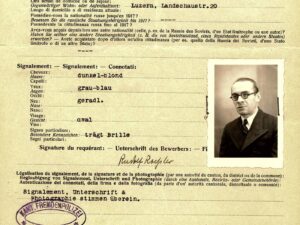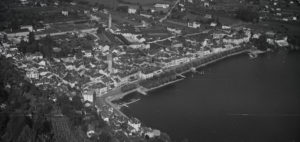
Secret meeting in Ascona
In March 1945, an SS general negotiated with the Allies over a German surrender in Italy. The meeting took place in Ascona, and ultimately shortened World War II by several days.
On 18 and 19 March 1945, the spring festival in honour of St Joseph was held on the piazza of Ascona. Despite the war, large crowds attended, and celebrated in high spirits. At the same time, a set of secret meetings was taking place in this little fishing village. These meetings are known today as ‘Operation Sunrise’ or ‘Operation Crossword’, and brought together high-ranking representatives of the warring powers around one table. Swiss mediators rounded off the panel. The subject of the negotiations was the surrender of the German armed forces in northern Italy.
The meeting attendees, all of them dressed in civilian clothes, were SS Obergruppenführer Karl Wolff, Major General Lyman L. Lemnitzer for the United States and Major General Terence S. Airey for the United Kingdom. The meeting had been organised by Allen Dulles, head of the Office of Strategic Services (OSS) in Bern – a US intelligence agency associated with the US War Department – together with his right-hand man, the German-American Gero von Schulze-Gaevernitz. Italian baron Luigi Parilli, Swiss intelligence officer Max Waibel, and Max Husmann, founder and director of the Montana Institute at Zugerberg, were also present. There were also adjutants, secretaries, translators and bodyguards. The group consisted of at least 20 people. The Russians were not present.
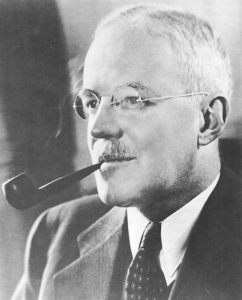
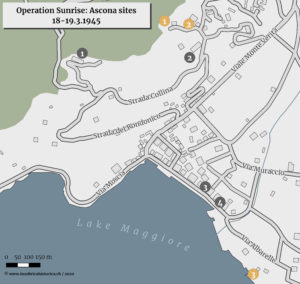
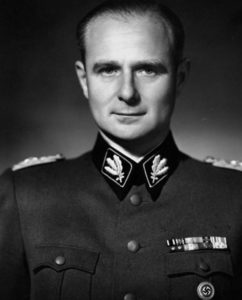
Several properties in the Ascona region were used for the meetings. While the Allied representatives took up residence at the Villa al Roccolo belonging to industrial magnate and anti-Nazi activist Edmund Hugo Stinnes, other participants stayed in various hotels as ‘tourists’. On 18 March, Karl Wolff and Allen Dulles met in a small house on Via Signore in Croce in Ascona. This house also belonged to Stinnes, who had made a number of premises available for the negotiations. The actual talks began on 19 March in the little Villa Margiana on the lakeside.
Karl Wolff, the highest-ranking SS and police leader in Italy, agreed to an unconditional surrender and made many concessions, such as the release of a number of important partisan leaders. In return, he was to receive a verbal guarantee of acquittal in the upcoming war crimes trial.
DISCUSSIONS ALREADY ONGOING SINCE AUTUMN 1944
The first contacts between the Germans stationed in Italy and the Allies had been made in autumn 1944. However, several setbacks delayed the negotiations. On 8 March 1945 Adolf Hitler ordered Field Marshall Albert Kesselring back to Germany to take over leadership of the entire Western front. According to Wolff, the most senior commander of the Wehrmacht in Italy would have been open to surrender negotiations. Any such surrender would only have been possible if both organisations, the SS and the Wehrmacht, had agreed to it. Kesselring’s return to Germany was a setback for Wolff. Albert Kesselring’s successor, General Heinrich Gottfried von Vietinghoff-Scheel, would first have to be persuaded. There were also delays on the American side. After the death of Franklin D. Roosevelt on 12 April 1945, Vice President Harry S. Truman, who had a sceptical view of the work of the OSS in Europe, took over. This took time. The Allied troops had by now reached Bologna.
On 29 April 1945, Operation Sunrise ended in Caserta near Naples. Lieutenant Colonel Viktor von Schweinitz, as representative of the Wehrmacht in Italy, and SS Major Eugen Wenner, as representative of the SS on the peninsula, signed the document agreeing to the local surrender of German armed forces in Italy. Hostilities were to cease on 2 May 1945. This surrender came very late. Large parts of Italy were already liberated, and the impact on the overall war was more modest than some of those involved portrayed in their memoires later on.
WHO BENEFITED FROM THE NEGOTIATIONS?
Operation Sunrise had advantages for many of those involved. SS General Karl Wolff was treated surprisingly leniently by the judiciary, despite his involvement in numerous war crimes. He spent less than nine years in prison, and died in 1984 at Prien am Chiemsee. SS Sturmbannführer Eugen Wenner was given no punishment at all, and worked for the CIA in South America after the war. Allen Dulles, who went on to become CIA Director, surely had a hand in this engagement.
The negotiations with Wolff put a significant shine on the poor operational performance of the OSS in Switzerland, and were a key argument for Dulles’ taking over directorship of the CIA. However, Dulles’ working methods remained contentious even after World War II. Under his leadership, several bloody coups d’état were carried out in Southeast Asia and in Central and Latin America. These events shaped US foreign policy for decades. In 1961 Allen Dulles was fired by J.F. Kennedy after the failed Bay of Pigs invasion in Cuba. He died in Washington in 1969 at the age of 75.
Max Waibel was promoted to military attaché in the USA in the immediate post-war period. He subsequently rose to the rank of Major General. However, his life ended tragically. Waibel was involved in the financial scandal of Lucerne private bank Ernst Brunner & Co., which ultimately ended in bankruptcy. As a member of the bank’s board of directors, the pressure became too much and he took his own life in January 1971.
THE ROLE OF SWITZERLAND
What role did Switzerland play in these secret negotiations? Officially, none. However, accommodating 20 people, including heavily armed bodyguards, in a small Ticino village and organising food and transport for them would have been impossible, in a time of food rationing and increased police checks, without the approval of the authorities. Switzerland benefited from Operation Sunrise because it was able to position itself as a neutral mediator in 1945. That was particularly important, given that the country had not put any obstacles in the way of the Third Reich, at least economically, in the preceding years.



